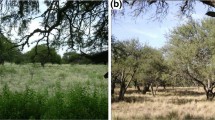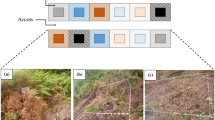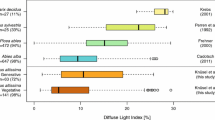Abstract
One of the challenges of understanding habitat requirements of endangered species is that the remaining populations may not be in optimal habitat, requiring experimentation to determine optimal habitat and to guide management. A better knowledge of its habitat requirements is important for the conservation of Streptanthus bracteatus, a rare annual of central Texas woodlands. The habitat requirements of a rare, declining species like S. bracteatus can also provide insights into anthropogenic habitat degradation and into previous disturbance regimes. We conducted a garden experiment and a transplant experiment to determine the effect of different light environments on the growth and reproduction of S. bracteatus. Higher levels of light improved S. bracteatus performance, especially fecundity. The optimum level of combined canopy and understory cover at the height of a S. bracteatus plant (≤0.5 m above ground) was less than 50 %. The remaining populations of S. bracteatus are in sub-optimal habitat because it is not open enough. The results are consistent with the hypothesis that this species was a “fire-follower.” The results also support the hypotheses that central Texas woodlands were once more open and that fire played an ecological role in these woodlands, an example of the ecological requirements of a rare species revealing past community structure and dynamics.







Similar content being viewed by others
References
Acácio V, Holmgren M, Rego F, Moreira F, Mohren G (2009) Are drought and wildfires turning Mediterranean cork oak forests into persistent shrublands? Agrofor Syst 76:389–400
Albrecht MA, McCarthy BC (2006) Effects of prescribed fire and thinning on tree recruitment patterns in central hardwood forests. For Ecol Manag 226:88–103
Boerner REJ, Huang J (2008) Shifts in morphological traits, seed production, and early establishment of Desmodium nudiflorum following prescribed fire, alone or in combination with forest canopy thinning. Can J Bot 86:376–384
Bourg NA, McShea WJ, Gill DE (2005) Putting a cart before the search: successful habitat prediction for a rare forest herb. Ecology 86:2793–2804
Bowles ML, McBride JL, Betz RF (1998) Management and restoration ecology of the federal threatened Mead’s milkweed, Asclepias meadii (Asclepiadaceae). Ann Mo Bot Gard 85:110–125
Bradstock RA, Bedward M, Scott J, Keith DA (1996) Simulation of the effect of spatial and temporal variation in fire regimes on the population viability of a Banksia species. Conserv Biol 10:776–784
Brys R, Jacquemyn H, Endels P, Blust GD, Hermy M (2004) The effects of grassland management on plant performance and demography in the perennial herb Primula veris. J Appl Ecol 41:1080–1091
City of Austin (2007) Balcones Canyonlands Preserve land management plan. Tier IIA. Chapter VII. Golden-cheeked warbler management. Wildland Conservation Division, City of Austin, Austin
Clark JS (1997) Facing short-term extrapolation with long-term evidence: holocene fire in the north-eastern US forests. J Ecol 85:377–380
Clark JS, Royall PD (1996) Local and regional sediment charcoal evidence for fire regimes in presettlement north-eastern North America. J Ecol 84:365–382
Colling C, Matthies D (2006) Effects of habitat deterioration on population dynamics and extinction risk of an endangered, long-lived perennial herb (Scorzonera humilis). J Ecol 94:959–972
Dey DC, Hartman G (2005) Returning fire to Ozark Highland forest ecosystems: effects on advance regeneration. For Ecol Manag 217:37–53
Dolan RW (1995) The rare, serpentine endemic Streptanthus morrisonii (Brassicaceae) species complex, revisited using isozyme analysis. Syst Bot 20:338–346
Elliott KJ, Hendrick RL, Major AE, Vose JM, Swank WT (1999) Vegetation dynamics after a prescribed fire in the southern Appalachians. For Ecol Manag 114:199–213
Eriksson O (1996) Regional dynamics of plants: a review of evidence for remnant, source-sink and metapopulations. Oikos 77:248–258
Fan Z, Ma Z, Dey DC, Roberts SD (2012) Response of advance reproduction of oaks and associated species to repeated prescribed fires in upland oak–hickory forests, Missouri. For Ecol Manag 266:160–169
Foster DR, Clayden S, Orwig DA, Hall B, Barry S (2002) Oak, chestnut and fire: climatic and cultural controls of long-term forest dynamics in New England, USA. J Biogeogr 29:1359–1379
Green SR, Arthur MA, Blankenship BA (2010) Oak and red maple seedling survival and growth following periodic prescribed fire on xeric ridgetops on the Cumberland Plateau. For Ecol Manag 259:2256–2266
Guerrant EO Jr, Kaye TN (2007) Reintroduction of rare and endangered plants: common factors, questions and approaches. Aust J Bot 55:362–370
Hanski I, Ovaskainen O (2002) Extinction debt at extinction thresholds. Conserv Biol 16:666–673
Hawkes CV, Menges ES (1995) Density and seed production of a Florida endemic, Polygonella basiramia, in relation to time since fire and open sand. Am Midl Nat 133:138–148
Hickman JC (1993) The Jepson manual: higher plants of California. University of California Press, Berkeley
Hobbs RJ, Huenneke LF (1992) Disturbance, diversity, and invasion: implications for conservation. Conserv Biol 6:324–337
Huang J, Boerner REJ, Rebbeck J (2007) Ecophysiological responses of two herbaceous species to prescribed burning, alone or in combination with overstory thinning. Am J Bot 94:755–763
Huntsinger L, Bartolome JW (1992) Ecological dynamics of Quercus dominated woodlands in California and southern Spain: a state-transition model. Plant Ecol 99–100:299–305
Hutchings MJ (1987) The population biology of the early spider orchid, Ophrys sphegodes Mill. I. A demographic study from 1975 to 1984. J Ecol 75:711–727
Hutchinson TF, Boerner RE, Sutherland S, Sutherland EK, Ortt M, Iverson LR (2005a) Prescribed fire effects on the herbaceous layer of mixed-oak forests. Can J For Res 35:877–890
Hutchinson TF, Sutherland EK, Yaussy DA (2005b) Effects of repeated prescribed fires on the structure, composition, and regeneration of mixed-oak forests in Ohio. For Ecol Manag 218:210–228
Kaye TN, Pendergrass KL, Finley K, Kauffman JB (2001) The effect of fire on the population viability of an endangered prairie plant. Ecol Appl 11:1366–1380
Kruckeberg AR (1986) An essay: the stimulus of unusual geologies for plant speciation. Syst Bot 11:455–463
Kutiel P (1994) Fire and ecosystem heterogeneity: a mediterranean case study. Earth Surf Proc Land 19:187–194
Leonard WJ (2010) Bracted twistflower (Streptanthus bracteatus): the ecology of a rare Texas endemic. MS Thesis, University of Texas at San Antonio, San Antonio
Liu H, Menges ES, Quintana-Ascencio PF (2005) Population viability analyses of Chamaecrista keyensis: effects of fire season and frequency. Ecol Appl 15:210–221
Loftis D, McGee C (eds) (1993) Oak regeneration: serious problems, practical recommendations. General Technical Report SE-84. United States Department of Agriculture, United States Forest Service, Southeastern Forest Experiment Station, Asheville
Maschinski J, Baggs JE, Sacchi CF (2004) Seedling recruitment and survival of an endangered limestone endemic in its natural habitat and experimental reintroduction sites. Am J Bot 91:689–698
Mayer MS, Soltis PS, Soltis DE (1994) The evolution of the Streptanthus glandulosus complex (Cruciferae): genetic divergence and gene flow in serpentine endemics. Am J Bot 81:1288–1299
Menges ES (1990) Population viability analysis for an endangered plant. Conserv Biol 4:52–62
Menges ES, Dolan RW (1998) Demographic viability of populations of Silene regia in midwestern prairies: relationships with fire management, genetic variation, geographic location, population size and isolation. J Ecol 86:63–78
Moreno JM, Oechel WC (1991) Fire intensity effects on germination of shrubs and herbs in southern California chaparral. Ecology 72:1993–2004
Nowacki GJ, Abrams MD (2008) The demise of fire and “mesophication” of forests in the eastern United States. Bioscience 58:123–138
Pepper AE (2010) Final report: the genetic status of the bracted twistflower, Streptanthus bracteatus (Brassicaceae), an imperiled species of the Balcones Canyonlands. Texas Parks and Wildlife Department, Austin
Pfab MF, Witkowski ETF (2000) A simple population viability analysis of the critically endangered Euphorbia clivicola R.A. Dyer under four management scenarios. Biol Conserv 96:263–270
Poole JM, Carr WR, Price DM, Singhurst JR (2007) Rare plants of Texas. Texas A&M University Press, College Station
Rackham O (1990) Trees and woodland in the British landscape; the complete history of Britain’s trees, woods, and hedgerows. Orion Publishing, London
Reemts CM, Hansen LL (2008) Slow recolonization of burned oak–juniper woodlands by Ashe juniper (Juniperus ashei). For Ecol Manag 255:1057–1066
Rodríguez-Rojo MP, Sánchez-Mata D, Gavilán RG, Rivas-Martínez S, Barbour MG (2001) Typology and ecology of Californian serpentine annual grasslands. J Veg Sci 12:687–698
Russell FL, Fowler NL (2004) Effects of white-tailed deer on the population dynamics of acorns, seedlings and small saplings of Quercus buckleyi. Plant Ecol 173:59–72
Schrautzer J, Fichtner A, Huckauf A, Rasran L, Jensen K (2011) Long-term population dynamics of Dactylorhiza incarnata (L.) Soó after abandonment and re-introduction of mowing. Flora 206:622–630
Scott JM, Heglund PJ, Morrison ML (eds) (2002) Predicting species occurrences—issues of accuracy and scale. Island Press, Washington
Seabloom EW, Williams JW, Slayback D, Stoms DM, Viers JH, Dobson AP (2006) Human impacts, plant invasion, and imperiled plant species in California. Ecol Appl 16:1338–1350
United States Fish and Wildlife Service (USFWS) (1990) Endangered and threatened wildlife and plants; final rule to list the golden-cheeked warbler as endangered. Fed Reg 55:53153–53160
United States Fish and Wildlife Service (USFWS) (2011) Endangered and threatened wildlife and plants; review of native species that are candidates for listing as endangered or threatened. 50 CFR Part 17. Fed Reg 76:66370–66439
Van Hecke L (1991) Population dynamics of Dactylorhiza praetermissa in relation to topography and inundation. In: Wells TCE, Willems JH (eds) Population ecology of terrestrial orchids. SPB Academic, The Hague, pp 1–13
Waite S, Farrell L (1998) Population biology of the rare military orchid (Orchis militaris L.) at an established site in Suffolk, England. Bot J Linn Soc 126:109–121
Wilkins N, Powell RA, Conkey AAT, Snelgrove AG (2006) Population status and threat analysis for the black-capped vireo. US Fish and Wildlife Service, Region 2 Albuquerque
Wright JW, Davies KF, Lau JA, McCall AC, Mckay JK (2006) Experimental verification of ecological niche modeling in a heterogeneous environment. Ecology 87:2433–2439
Zippin DZ (1997) Herbivory and the population biology of a rare annual plant, the bracted twistflower (Streptanthus bracteatus). PhD Dissertation, University of Texas, Austin
Acknowledgments
We thank Lisa O’Donnell for facilitating this project; Alan Pepper, Dana Price, and members of the Bracted Twistflower Working Group for useful discussions; Karen Alofs, Christina Andruk, Chris Best, Laurel Fox, Lisa O’Donnell, Mark Rees, and two anonymous reviewers for comments on earlier versions of the manuscript. Funding provided by Texas Parks and Wildlife Department (Section 6 award). We thank Brackenridge Field Laboratory, University of Texas at Austin, where the garden experiment was conducted, and Balcones Canyonlands Preserve, City of Austin, for providing a site for the field experiment.
Author information
Authors and Affiliations
Corresponding author
Electronic supplementary material
Below is the link to the electronic supplementary material.
Rights and permissions
About this article
Cite this article
Fowler, N.L., Center, A. & Ramsey, E.A. Streptanthus bracteatus (Brassicaceae), a rare annual woodland forb, thrives in less cover: evidence of a vanished habitat?. Plant Ecol 213, 1511–1523 (2012). https://doi.org/10.1007/s11258-012-0109-2
Received:
Accepted:
Published:
Issue Date:
DOI: https://doi.org/10.1007/s11258-012-0109-2




